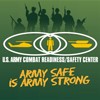Title Page
-
Site conducted
-
Conducted on
-
Prepared by
-
Location
Demographic Data
-
Battalion
-
Company / Battery
-
Mission
Safety Culture
-
Commanders have a Safety motto, vision, or goal for this exercise?
-
Soldiers know the Safety motto, vision, or goal?
-
DD Form 2977's are complete and signed by the appropriate authority for the exercise / mission?
-
Safety is addressed in the Operations Order and all subsequent orders?
-
The mishap reporting process is clearly defined and displayed prominently?
-
All mishaps, injuries, and near miss incidents are being reported and investigated
-
Command involvement positively effected the Safety culture with defined Safety objectives and provided adequate resources
-
Appointed Unit Safety Officers (USO) are trained in their responsibilities and communicated hazards to Command teams.
-
Commanders hold individuals accountable to Safety standards and assure realistic timelines that provide for sufficient mission planning. (20/80 time rule)
Safety Leadership
-
Commanders have completed the Leaders Safety & Occupational Health Course (LSC)?
-
Command teams have Safety awards and defined criteria for nominations and approvals?
-
Commanders have approved Pre-Mishap Plans, Emergency Action Plans, Mishap Logs, Hazard Logs, and similar documents?
-
Commanders have appointed qualified Soldiers to perform USO duties?
-
USOs are afforded time and resources to perform Safety functions? USOs are not assigned any other additional duties that limits availability for Safety concerns.
-
USOs conduct and document daily walk-around inspections?
-
Safety recommendations are implemented in a timely manner?
-
Based on interviews with Commanders and leaders, what were the top hazard prevention priorities for the mission / exercise?
- Vehicle Accident Prevention
- Drivers Training & Hazards
- Risk Management (RM)
- Mission Safety Briefings
- Slips, Trips, & Falls
- Workplace Hazards
- Personal Protective Equipment
- Weapons Safety
- Hot Weather Injuries
- Electrical Safety
- Physical Training Injuries
- Sports Related Injuries
- Safety Training
- Arms, Ammunition, & Explosives (AA&E)
- Wildlife
- Enviornmental
- Ergonomics
- Other On-Duty Injuries
- Other Off-Duty Injuries
Safety Behaviors
-
Are Soldiers using Personal Protective Equipment (PPE) and is there enough PPE available for all Soldiers?
-
Soldiers are not taking shortcuts or violating Safety standards?
-
Soldiers are adequately supervised and on-the-spot Safety corrections are being made?
-
Soldiers know who to report to and how to report a mishap, injury, or near miss.
-
Are Soldiers performing unsafe acts?
-
Soldiers have a sense of ownership in the Safety program.
-
Based on observations, Safety Behavior errors are related to which type(s) of failure?
- Individual Failure
- Leadership Failure
- Training Failure
- Support Failure
- Standards Failure
- None
Safety Training
-
Are hazards identified and controls implemented for collective METL tasks?
-
Is the unit tracking any type of Safety metrics?
-
Are controls in place for remedial or refresher training?
-
Are equipment operators properly licensed?
-
Was the Pre-Mishap Plan and Inclement Weather Plan rehearsed?
-
USOs meet regularly with planners to discuss upcoming training and/or missions?
-
Based on observations, is there an Individual or Collective Safety training gap?
-
If yes, explain the shortcoming.
Safety Statistics
-
Available Strength
-
On-Duty Mishaps
-
On-Duty Injuries
-
Near Miss
-
Mishap Rate
-
Injury Rate
-
Mishap / Injury Log available?






